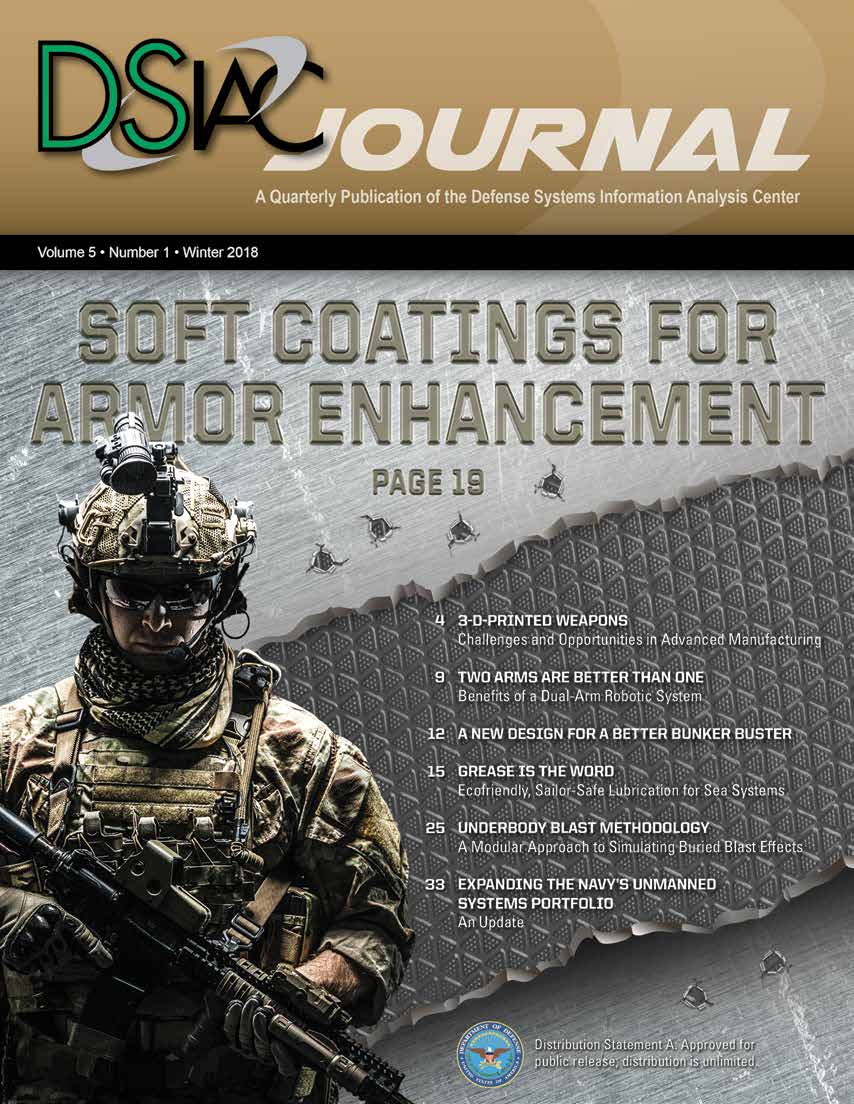an email newsletter released every month highlighting the latest articles, events, technical inquires, and voices from the community
Winter 2018: Volume 5 Number 1

Winter 2018: Volume 5 Number 1
Published: March 1, 2018
Each issue of the DSIAC Journal has its own set of uniquenesses that makes it a featured product for the defense community. This winter issue is no exception. The twist in this journal is the inclusion of what we are dubbing Technology Spotlights. The Technology Spotlight articles are designed to succinctly review the need for and development of cutting-edge technologies for defense applications.
This issue includes three Technology Spotlights — one on dual-arm robotic systems, a second on a new case for the BLU-122 penetrator, and a third on grease for marine applications. The article “Two Arms Are Better Than One,” written by RE2 CEO Jorgen Pedersen, showcases the benefits of a dual-arm robotic system for, in one application, investigating and defusing improvised explosive devices. In “A New Design for A Better Bunker Buster,” Gregory Vartanov of Advanced Material Development Corporation describes the materials-based improvements to the BLU-122 bomb — specifically, to its case — which will allow for deeper penetration effects. Finally, the article “Grease is the World” by Sarah Peckham of Texas Research Institute/Austin presents a survey of greases based on their ability to lubricate parts in a marine environment, keep the sailor safe, and reduce environmental effects.
Beyond the Technology Spotlights, the remaining four articles come from the Navy Research Laboratory (NRL), the Army Research Laboratory (ARL), industry, and the Navy’s Program Executive Office (PEO) for Littoral Combat Ships (LCS).
The feature article, written by NRL’s Michael Roland, provides an overview of the latest in “Soft Coatings for Armor Enhancement.” This research advances ballistic protection capabilities that also offer tactical advantages through lighter-weight armor. The work even shows promise of repairable, transparent, wearable armor!
Not to be outdone in the area of survivability, ARL has contributed the “Underbody Blast Methodology” article, which describes the Army’s modeling methodology to simulate buried blast attacks against ground vehicles. Ultimately, the methodology is used to understand underbody blast phenomena and thus better protect the Warfighter.
InfraTrac’s Sharon Flank writes from the perspective of enhancing and protecting U.S. weapon systems in her article “3-D-Printed Weapons: Challenges and Opportunities in Advanced Manufacturing.” In this article, recent achievements in 3-D printing weapons are reviewed to highlight the value of the technology and importance of certain considerations, such as part qualification and authentication.
Finally, in “Expanding the Navy’s Unmanned Systems Portfolio,” Howard Berkoff of the Navy’s PEO LCS gives a wide-angle overview of the Navy’s ever-growing surface and underwater vehicles of the unmanned variety. This article provides a unique one-stop-shop for informing the reader of the latest in programmatics of the Navy’s unmanned systems.
With these seven distinctive articles, including the new Technology Spotlights, I hope you enjoy all the features provided in this latest issue.
Articles From This Issue
There are no articles in this issue.

